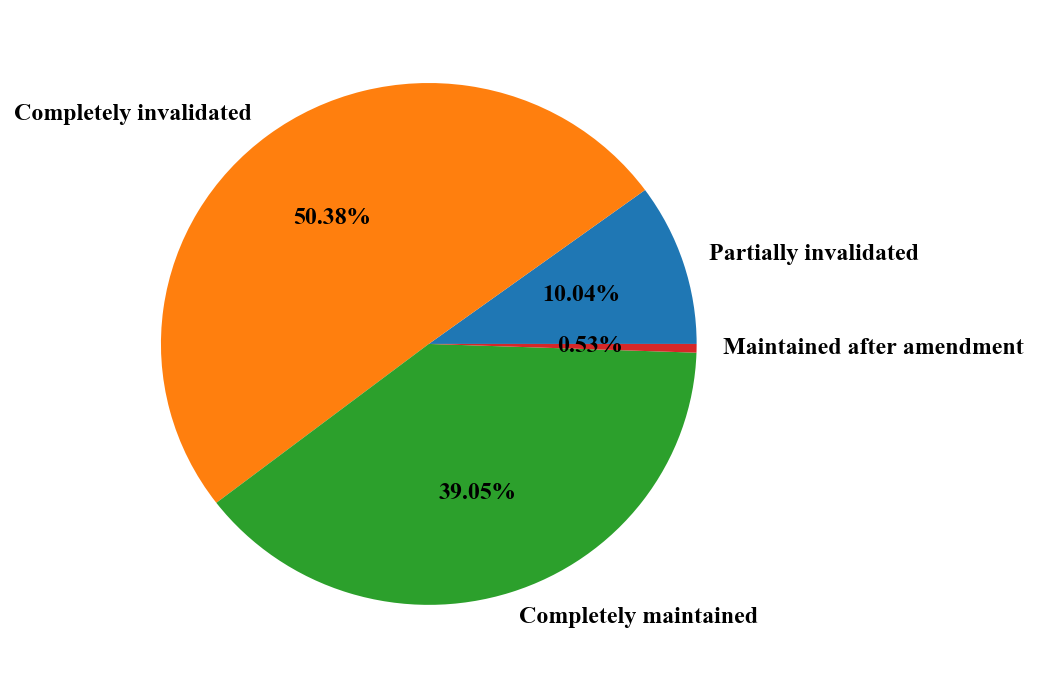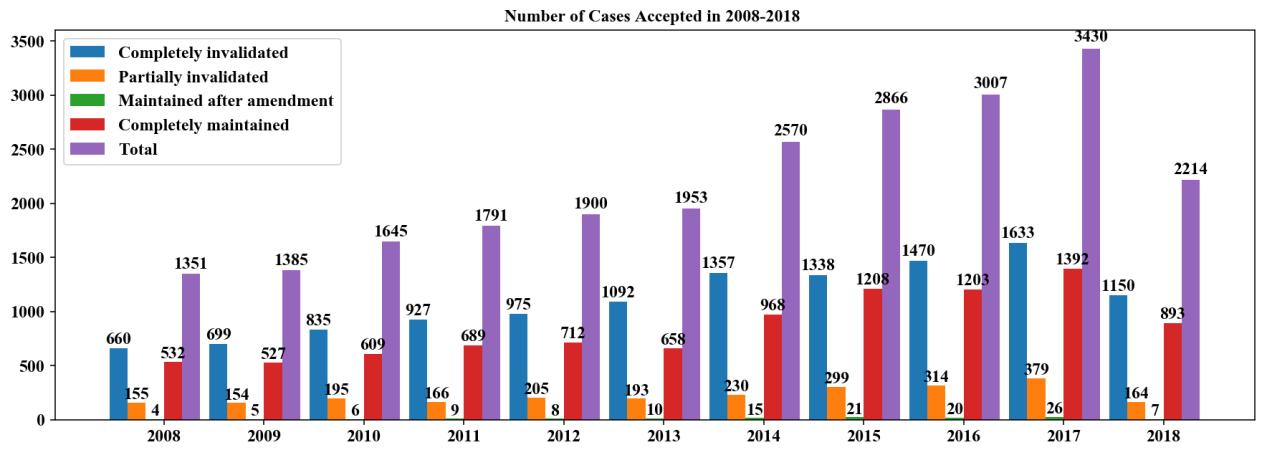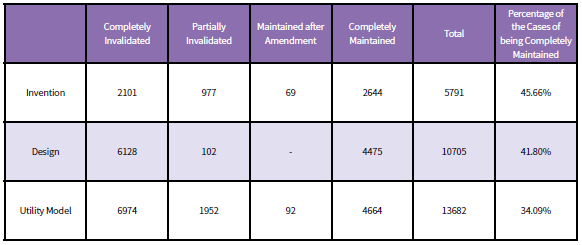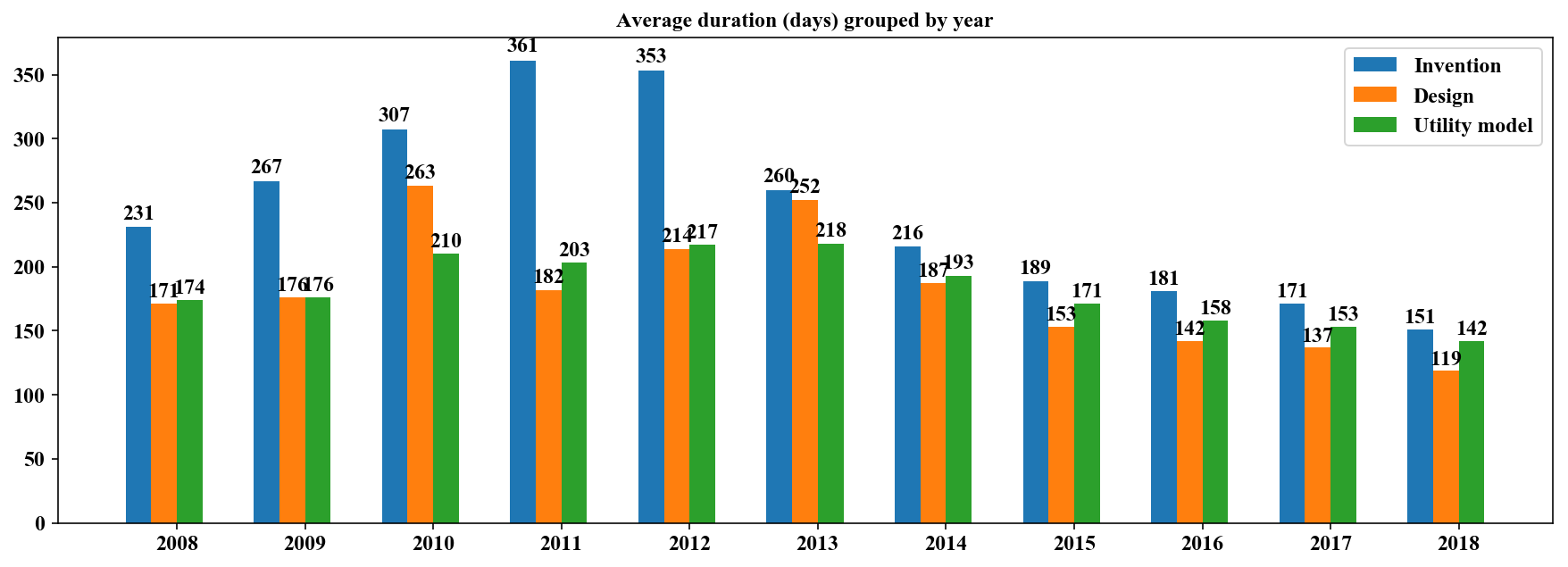Report on Statistics of Patent Invalidation Cases in China from the Year of 2008 to 2018
Zheng Haiyang
Foreign Patent Agent, Trainee Lawyer
Patent invalidation means that where, starting from the date of the announcement of the grant of the patent right by National Intellectual Property Administration, PRC (CNIPA), any entity or individual considers that the grant of the said patent right is not in conformity with the relevant provisions of the Chinese Patent Law, it or he may request the Patent Reexamination Board (hereinafter referred to as the “PRB”) of the CNIPA to declare the patent right invalid. The patent invalidation system is set for revoking the patent right granted to the invention-creations not satisfying the granting conditions under the Chinese Patent Law, maintaining fairness of the grant of patent right and protecting the public interests. In judicial practices at present, accused infringers would file request for invalidation of the patent involved nearly in every patent infringement case, which has almost become a “necessary link” in patent infringement litigation. Therefore, the patent invalidation procedure is of great significance to both the patentee and the public.
The PRB of CNIPA would regularly publish the decisions of invalidation that have been made, but it does not provide relevant data statistics or analysis on the decisions made in the past years. It is hard for the public to read the whole tendency and regularity from every single decision. Accordingly, the author of this report makes so bold as to sort and statistically process all the decisions of invalidation published on the official website1 of the PRB, obtaining some data2 and herein sharing them for reader’s reference.
I. Overview of Decisions of Invalidation
30,178 pieces of decision of invalidation (which, including those before 2008, at least have key information usable) are collected this time, wherein there are 15,203 pieces of decision of invalidation where the patent right is announced to be completely invalidated (hereinafter referred to as “completely invalidated”), accounting for 50.4% of the overall cases, there are 3,031 pieces of decision of invalidation where the patent right is announced to be partially invalidated (hereinafter referred to as “partially invalidated”), accounting for 10.0% of the overall cases, and there are 11,783 pieces of decision of invalidation where the patent right is maintained valid (hereinafter referred to as “completely maintained”), accounting for 39.0% of the overall cases, and there are 161 pieces of decision of invalidation where the patent right is maintained valid after amendment (hereinafter referred to as “maintained after amendment”), accounting for 0.5% of the overall cases. Accordingly, the decisions where the claims are at least partially invalidated account for over 60% of the overall cases.


The above figure shows the number of the requests of patent invalidation accepted and closed from the year of 2008 to 2018. It follows that the number of the requests of patent invalidation has been increased year by year for the past ten years. About 50% of the cases accepted in each year were announced to be completely invalidated. Accordingly, counting the cases of being partially invalidated and those maintained after amendment, the decisions where the patent right is at least partially invalidated accounts for more than or almost equal to 60% of the accepted cases.
It should be noted that it seems the number of cases in 2018 is relatively less, but it cannot be simply deemed that the number of the requests for invalidation is reduced in 2018 since the possible reason is that there are many cases accepted in 2018 that are not yet closed.
1.2 Statistical data grouped by patent types

The table above shows the number of cases grouped by patent types. On the whole, the percentage of the invention cases as completely maintained is higher than the cases of design and those of utility model. The probability that the patent is announced to be invalidated is gradually increased in a sequence from the invention to the design to the utility model. This is consistent with the general inference, that is, the ratio of the cases of utility model being invalidated is much higher because of low stability of the cases of utility model. To some extent, the low stability of utility model patents has substantially increased the proportion of patents that have been declared invalid.
It can also be seen from the table above that the number of the requests for invalidation of invention is remarkably smaller than those of utility model and design, which is even less than half of the number of the requests for invalidation of utility model.
II. Duration of Patent Invalidation Cases
2.1 Statistical data grouped by year

The above figure shows the average duration (days) of patent invalidation cases from the year of 2008 to 2018. As can be seen from the above figure,
(1) On the whole, the duration of the invalidation cases in each year substantially tends to be reduced from the year of 2011, which is maintained to be within about six months (180 days) after the year of 2015 and even reduced to be within five months in the years of 2017 and 2018. It should be noted that some time consuming cases accepted in recent years are not yet closed or are being in the administrative litigation, which therefore are not published up to now. As a result, the actual duration of the cases accepted in recent years may be longer than that provided in the above figure.
(2) Regardless of the year, duration of invention cases is longer than those of the cases of utility model and design; generally, duration of design cases is the shortest.








